Living in Rouyn-Noranda, Québec, Barb and Con Campbell heard that Gold Belt Air Service was looking to replace their man at remote Bachelor Lake. They jumped at the chance to take over the year-round job. They would refuel the company aircraft, keep the two-way radio operating, report the weather, and provide shelter so airplanes and people could stay overnight if the weather turned bad. In August 1950, pilot Howard Watt flew them in to the base in Norseman CF-BSE. Barbara later wrote of their experiences under the title “Bachelor Lake Daze.” Here she describes their arrival at the float plane base.
To view all posts from “Bachelor Lake Daze,” click on the Gold Belt Air Service category below the main title at the top of the page.
Half the Battle is Getting There
by Barbara Van Orden Campbell
After a 60-mile road trip from Noranda to Amos with our friend Ben in his panel truck, I had developed a nervous tic by the time we arrived. When Ben got behind a wheel, although he was a good-natured character of great kindness, the Dr. Jekyll in him was rudely elbowed aside by Mr. Hyde. How grateful I was to see flying machines with wings when we arrived at the Gold Belt air base at Figuery Lake near Amos!
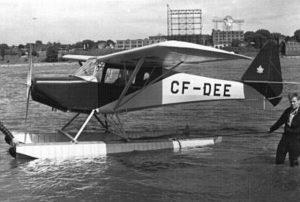
Photo: Canada Aviation and Space Museum #14450. CF-DEE – a two-seater Fleet 80 “Canuck” – on floats. (The original Fleet float design is shown here.)
Although it was still early in the morning, most of the planes were already away on the day’s flights. A pair of Fleet Canucks were bobbing daintily in the rough water, looking so small I felt they must have been hatched from eggs. Of the mighty Norsemen, the wheel-horses of the Gold Belt fleet, there was no sign.
A long, lean individual was weighing boxes and bundles on a huge scale beside the radio shack at the end of the wharf when we touched down. Con got out and walked over to him while I stood uncertainly beside the truck with Ben and his friend Johnny, a roving reporter who had made the trip with us.
“That’s Bob Birkett,” Ben muttered to me. “Head man up here in Amos. You’ll like him when you get to know him, but he takes a lot of knowing. Heck of a fine pilot, too.”
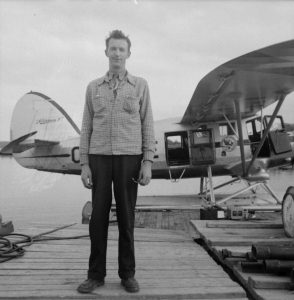
Photo: Bibilothèque et Archives nationales du Québec # 03Q-E6S7SS1P78816. Bob Birkett at the Figuery Lake base with Norseman CF-BSE.
Con and Bob walked back to where we were standing. Bob was built along the lines of the Eiffel Tower only not so meaty.
He acknowledged the introductions without interest and stared off into space.
Time passed, and the staring continued – not unfriendly, just preoccupied. Con asked him when we might expect to get a lift in to Bachelor.
“Depends. You can unload your gear over there by the scales.” He turned and went back to his weighing.
“A real chatterbox, that man!” Con observed.
Hurry Up and Wait
A half-hour later, a Norseman bellowed in and disgorged a horde of shaggy men, refuelled, and roared off down the lake bulging with a load of diamond-drill equipment. While they were gassing up, reporter Johnny had Con and me stand on the plane’s float and took our self-conscious pictures, promising he’d never, never print them. Soon after that, he and Ben bade us farewell and went scorching off toward Noranda, leaving us to our waiting game.
We wandered about, talking to the mechanics and getting underfoot. Our belongings looked forlorn, piled in that impersonal setting. The ironing board I’d insisted on taking kept toppling over and looking more out of place than ever. Noontime came and Bob wandered over.
“Might as well go and eat,” quoth Robert the Silent. “Come on.”
We drove with him in to Amos and dined at the Chateau Inn, bought our groceries and returned to the lake without having exchanged more than the barest of civilities with our host.
Came two o’clock and another Norseman landed and taxied up to the wharf.
“Your turn,” announced Gabby Bob, as the propeller flailed to a stop.
Appallingly Noisy Norseman
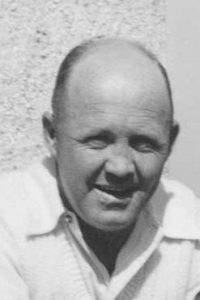
Photo credit: Lloyd Watt. Courtesy Bill Watt. As a bush pilot, Howard Watt flew mainly in the Lower St. Lawrence and North Shore regions of Québec.
Out stepped the pilot and I was surprised to find I knew him. Howard Watt had been the pilot for the company for whom I had worked a few years before, but we had not met for a long time.
He expressed some amazement when he learned our destination, and some doubt as to whether he could get us in that afternoon.“It’s terrifically windy up north today and getting windier. Had a heck of a time landing at Bachelor this morning.”
He scanned the sky carefully, noting the clouds scudding before the stiff breeze. “We’ll make a try at it anyway. Con, you give a hand to load your paraphernalia while we’re fuelling up. What are you going to do with the ironing board, Barb? Start a laundry? There’s not an ironed shirt north of Puskitamika Lake, or a clean one either, as far as I know,” he mused.
“Well, there’s going to be!” I stated flatly. I was to ponder that statement for years to come.
The loading and refuelling were completed while Howard made radio contact with the planes that were away, to get their weather reports. Thunderstorms, he was told, with high winds, but nothing big enough to worry about.
The Norseman aircraft, this particular one bearing the call letters CF-BSE painted in black letters on her silvery wings and fuselage, is a roomy and efficient bush aircraft, and I was to come to love the breed like brothers. They are also appallingly noisy, and they do a lot of loudmouthed bragging about how hard they are working and how high they are flying.
I was positive, in the last ear-splitting effort just before BSE was airborne, that the whole works was about to come unglued. I felt that nothing could make that much uproar and still function, so I waited tensely, expecting every second to find my lap full of piston rods. But she gently shook the water from her floats and climbed snarling into the blue.
It is 115 air miles in a north-easterly direction from Amos to Bachelor Lake. At this time it was not accessible by any other means, although a railroad through the area from Senneterre to Chibougamau was proposed, and a winter road had been cut through to Bachelor Lake and had been used in previous winters to haul diamond-drill equipment in by tractor train.
Bachelor Lake itself lies just east of Waswanipi Lake and 80 miles southwest of Chibougamau. It is shaped roughly like the peninsula of Italy, lying east and west, and is approximately two miles long and a mile wide at the foot of the boot. Gold Belt’s base was situated on a point of land on the heel. Ordinarily it takes about an hour to fly in from Amos, and somewhat longer from Rouyn, it being 45 miles further.
We were in the air longer that day as we were forced to sidestep the numerous thunderclouds looming in our path. The wind was blowing strongly on our quarter and I was amused to look down where the shadow of the plane rippled over the surface below us and see that the gale of wind was blowing against the tail surfaces with such force that it was quite out of line with our line of travel, just like a hound dog.
After leaving Amos we passed over farming country until we reached the Bell River. Sunshine and shadow carpeted the earth below, the sunlight glinting brightly from the aluminum rooftops of many barns. As the farms fell away behind us the lakes became more numerous, sparkling green or blue in the sun or glittering in metallic grey or black where they were shadowed by clouds. The Bell River snaked its quick-silvery way northward and Quevillon Lake lay flecked with white caps.
The green bush closed in then, and there was nothing to see in any direction but woodland, the trees as thick as fur, and myriads of tiny lakes. The scenery seemed unchanging. It gave me a feeling of being suspended in time and space, as though we weren’t moving at all, but were being held stationary by some invisible air current. The blue of a large body of water appeared and we soon passed between sprawling Puskitamika Lake on the right and off the port wing, Waswanipi Lake with its Hudson Bay Post.
Losing altitude, Howard pointed ahead to a lake that looked much like all the others. “Bachelor!” he shouted above the roar of the motor. Con was sitting on a drum of naphtha behind my seat. He leaned forward to get a better view of our future home.
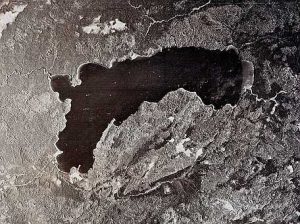
Photo: Department of Energy, Mines and Resources #A 13665-75. Bachelor Lake in 1953 with its distinctive boot-like shape.
Howard flew the plane low over the west end of the lake and we caught a glimpse of tiny cabins, set like toys on a point of land wooded by tall spruce trees. Circling into the wind, the plane landed neatly and taxied back across the windswept water toward a wharf jutting out from the shore.
“Get set to jump out on the wharf and hold the wing, Con – this wind isn’t fooling!” Howard yelled.
Presently we stood on the wharf, and while the wind buffeted us strongly we had our first look at our home. I stared around in all directions while my ears popped and snapped from the sudden change in altitude. The plane was at last tied securely and I turned to help with the unloading, but Howard said, “Wait. We’ll have a look around before you take your things out of the plane. Maybe you’ll decide to come back with me. This place is pretty grim.”
We Meet the Chamber of Horrors

Photo: Bibilothèque et Archives nationales du Québec # 03Q-E6S7SS1-P66471. A new cabin welcomed the Campbells to Bachelor Lake.
About 50 feet back from the wharf sat a tiny log cabin. It was new, and its one room contained only a table and a steel double-decker bunk.
“This is the new cabin,” Howard explained. “Guess you could sleep over here yourselves – it’s still fairly clean,” he pointed out.
Next door there was a larger log building of more ancient vintage, its lines faithfully undulating along the contour of the ground it was built upon. It seemed to be slouching its way down the slope to the lake. Howard pushed open the door and stood back for us to enter.
“You’re not going to like it!” he predicted jovially. But we were in no mood to be daunted by the dirt, the gloom, and the evil smell that hit us like an uppercut as we walked in. Still, it was a shocker. It didn’t matter if we started from the bottom and looked up or if we began at one side and let our gaze wander to the other wall – what we saw just went from bad to worse.
The one-roomed Chamber of Horrors was floored with poles, more or less flattened on one side, and encrusted with an unbelievable accumulation of dirt. The logs which formed the four walls were encased in a scum of smoke-blackened grease, and in the tiny windows the filthy glass was unframed and only held in the openings by the occasional nail. Slightly overhead sagged a ceiling of grimy paper in an inexcusable shade of pink. A cook stove, a rickety table, a bunk bed, and some sagging shelves made up the furnishings. The radio equipment stood along one wall and was the only wholesome looking thing in the whole shebang. In one corner loomed a pile of assorted foodstuffs and it was from this gamey heap that the smell originated.
We gaped at this gruesome sight until the silence became oppressive. “Well,” said Howard briskly, “How do you like it?” I tried to look undismayed, and swallowing hastily to keep my lunch aboard, I replied, “It’s not too bad – I guess,” in what I hoped was a light-hearted tone.
Con was already inspecting the radio equipment and didn’t answer. The radio got its power from four 12-volt automobile batteries, and we listened intently as Howard explained how we had to keep the batteries charged by running a small charger which was connected up outside. The radio was both a receiver and transmitter and looked to me to be as complicated as a cyclotron, but it seemed to hold no mysteries for Con.
“There’s a crew of prospectors over at Waswanipi Lake – they have a small set-up over there. I’ll see if I can raise them,” Howard said. He picked up the hand microphone after switching on the transmitter and pressed the button. The needle on a gauge on the front of the set wavered weakly from left to right as he spoke into the mike.
“Not much juice in your batteries, Con – you’ll have to re-charge them tonight or you’ll not be able to get out on the radio at all tomorrow. And don’t forget to keep this transmitter switch turned off when you’re not using it or it’ll run the batteries down in no time.”
He contacted the party at Waswanipi, and Con and I both had a crack at speaking with the operator there. All the radio jargon seemed strange to me, but it was soon to become natural and we quickly got over feeling self-conscious about it, although I could plainly see where the term radio “ham” originated.
When the lesson on “How to Operate and Maintain a Radio-Phone” with “Footnotes on How to Make Repairs with No Tools” was over, Howard suggested we go next door and meet our neighbour.
Our Fine Neighbour Alphonse
“Neighbour?” Con asked, “I thought there was no one here but us!”
“Didn’t you know that Fecteau Airways of Senneterre has a base here, too? That’s their base right over there.” Howard pointed through the fly-specked window to a trim-looking cabin about 300 feet west of us. Between the two cabins bulked a large log building roofed with corrugated iron.
“What’s that imposing looking structure?” Con wanted to know. “The city hall?”
“Nope…Demorest Diamond Drilling Company’s warehouse. Come on, I’ll introduce you to Alphonse – he’s a pretty good chap. Then I’ve got to high-tail it back to Amos – I don’t like the look of this weather.”
The wind smelled like Chanel No. 5 when we stepped out of the reeking cabin and followed Howard down the trail. There were gasoline drums piled around the warehouse next door and I wondered if they were full or empty. The clearing where all the buildings stood was covered with tall grass growing between the numerous stumps. The trees that ringed the clearing were very tall and thin, packed close together like reeds, with tufts of green branches at the tops.
Meeting Alphonse Truchon for the first time, we had no way of knowing what a fine neighbour we had found. He was busily engaged in building a porch on his sturdy cabin but put down his saw to come and shake hands with us. A man past middle age, he was not tall but built strongly and compactly, and walked with a springing step. His hair showed white beneath his cap and his tanned face grinned in a friendly way.
“Glad to see I’m going to have some neighbours,” he smiled. “Anything I can do to help you get settled, just give a shout. We may be working for rival companies but in here in the bush we help each other out whenever we can.”
Reassured by this Christian attitude, we returned to where the aircraft bounded in the heavy seas and did the stevedore act with our goods just in time to get everything thoroughly soaked by a lashing, but mercifully short, shower of rain.
A Rainbow at the End of the Day
“I’ll probably be in again the first of the week,” Howard told us. “If there’s anything you need to make yourselves more comfortable in here let us know by radio.”
“We’ll send out an alphabetical list,” Con assured him. “I’ll get those batteries charged up tonight for sure.”
We untied the plane and held fast to her wing struts until the motor roared into life. Swinging into the wind she was soon screaming her way off the water and grumbling away into the distance.
Turning, Con and I looked at each other and then at the cabins while the wind soughed in the spruce branches overhead. Suddenly we both saw, against the rain-blurred blue of the eastern sky, the brilliant arch of a rainbow beneath which BSE seemed to be suspended. To us, that beautiful and symbolic sight captured our hopes for the days ahead at Bachelor Lake.
Excerpted from “Bachelor Lake Daze” by Barbara Van Orden Campbell, by kind permission of Dr. Sandra Campbell and Con Campbell, Jr.
About Barbara Van Orden Campbell https://flightsofhistory.perfectdayfactory.com/barbara-campbell-biography/

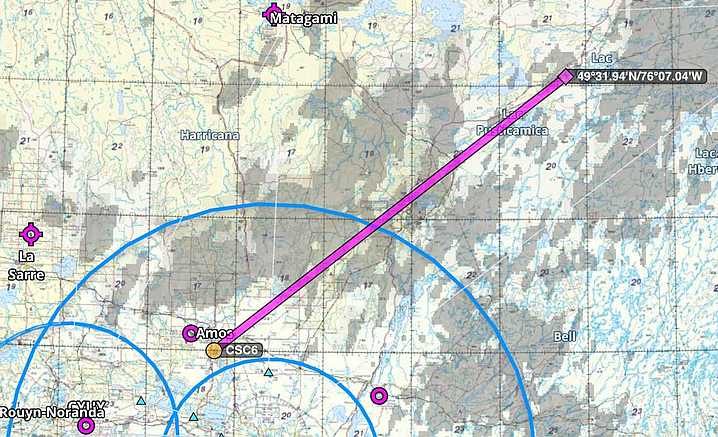
Recent Comments